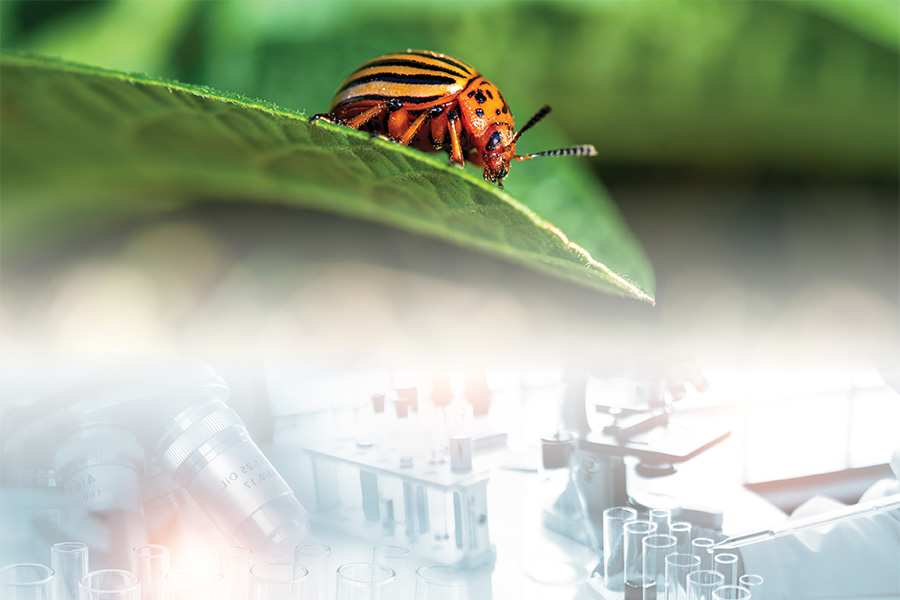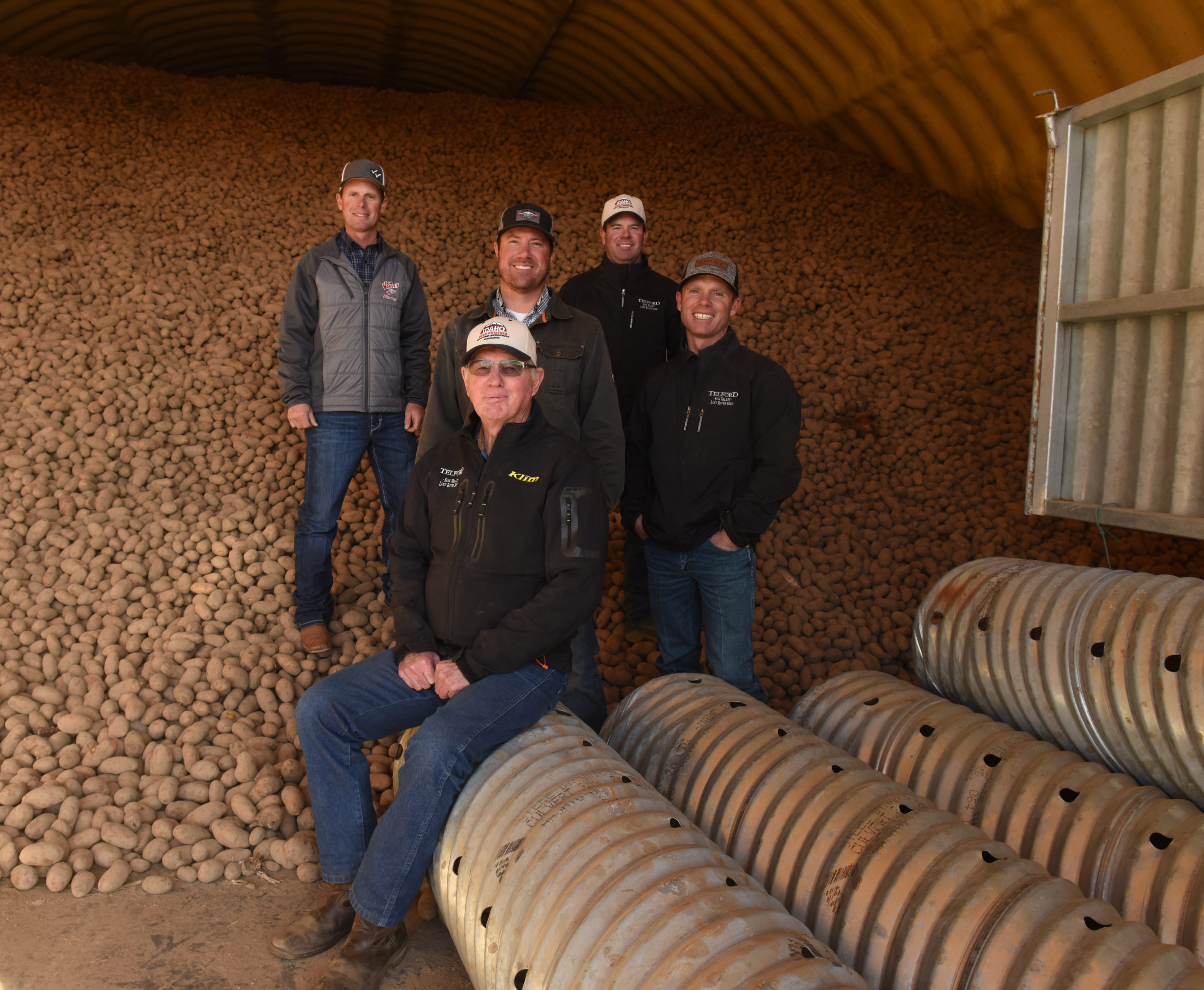
Fast-rising alternative aims to combat familiar foe
As well as a state name, Colorado is a Spanish word for the color red, and it may well be this second meaning — in addition to geographical location — that lends its name to a pest that has become a major threat to produce crops across North America.
Bright red as a larva before growing into its striped adult form, the Colorado potato beetle impacts leafy plants across the region, feeding on potato, eggplant and tomatillo leaves, among other crops, and impairing their growth.
Active in the spring months, when most tubers begin to sprout, Colorado potato beetles can do an impressive amount of damage for a bug that typically only grows to 3/8 inch.
According to the University of Minnesota (UMN), although potatoes can normally tolerate as much as 30% defoliation before flowering, the bugs can cause real harm after this stage commences.
During flowering — effectively when tubers begin to amass bulk — they are much more susceptible to damage, with plants only able to tolerate around a 10% loss of foliage.
However, combating this problematic pest has proven to be anything but straightforward over the years. According to UMN, Colorado potato beetles quickly develop resistance to pesticides, with researchers finding that the insects are now resistant to more than 50 different active ingredients in agrochemicals.
Essentially, this means that, aside from continually rotating insecticide products, growers require fresh solutions to an age-old challenge. Vancouver, Canada-based Renaissance BioScience believes it has found one.
 A bioengineering specialist that develops functional non-genetically modified organisms (GMO) or GMO yeasts to provide solutions for environmental, health and industrial challenges, Renaissance has recently introduced a yeast that kills the insects without negative effects on other animals, insects, plants or humans.
A bioengineering specialist that develops functional non-genetically modified organisms (GMO) or GMO yeasts to provide solutions for environmental, health and industrial challenges, Renaissance has recently introduced a yeast that kills the insects without negative effects on other animals, insects, plants or humans.
John Husnik, Renaissance co-CEO and chief science officer, said the company has developed a yeast that expresses an RNA interference (RNAi), a system which precisely targets a specific pest’s genes for interference.
The RNAi biopesticide works by targeting ribonucleic acid (RNA) molecules, a substance essential for most biological functions.
“It is important to note that RNA is a perfectly natural part of every animal and human and has been for millions of years,” Husnik said. “RNAi, or RNA interference, is a natural mechanism that can interfere (with) or ‘dim’ the usual operation of genes. We developed a proprietary yeast that can express bioactives that target specific critical genes of a targeted pest via RNAi.”
The yeast, which is killed prior to application, acts as a “suitcase,” Husnik said, to protect the fragile bioactive in the environment, allowing the RNAi yeast to be sprayed in a solution onto plant leaves much like a conventional pesticide.
“Once the pest eats the leaves and digests the (now dead) yeast, the RNAi bioactive gets released in the gut, ultimately turning off the selected critical genes and killing the insect,” he said.
Husnik argues that using food-safe yeast to produce an RNAi bioactive also addresses some of the biggest challenges facing RNAi biopesticides, including fragility, cost and scalability.
“Yeast is hardy and can protect the fragile RNAi bioactive molecule it contains while being in the outside agricultural environment or the pest gut,” he said. “It can be easily and economically manufactured at large scale, overcoming the high costs typically associated with other RNAi biopesticide technologies.”
A MICROORGANISM WORKHORSE
Husnik said Renaissance’s inspiration to marry two very different types of technologies — RNA technology and yeast technology — arose from a fundamental study of yeast.
For Husnik, yeast is a “workhorse microorganism” that can be made to do many things that are needed in the economy.
“We noted that yeast is naturally very good at making RNA molecules, particularly double-stranded molecules used in RNAi and harboring these molecules safely within the cell,” he said. “With this basic knowledge we have been building out our yeast-based RNA platform technology for biopesticide use and beyond.”
Drawing on Renaissance’s experience in the development of yeast covering a range of food, beverage, agriculture and animal/human health applications, Husnik said the company’s scientists focused on creating a yeast that could overcome hurdles to bringing an RNAi biopesticide to market.
At its core, Husnik said the RNAi biopesticide has been developed to be “extremely specific” in its focus targeting Colorado potato beetles. It is this factor, in particular, that he believes gives it a distinct advantage over conventional broad-spectrum pesticides.
“Any excess yeast containing the RNAi bioactive breaks down harmlessly on the sprayed leaves and into the surroundings without harming other living organisms, whereas conventional pesticides can lead to pesticide runoffs that contaminate water sources, putting aquatic life and human health at risk,” Husnik said.
A further advantage, he said, is the biopesticide’s positioning as a “plug-and-play” technology, where RNAi bioactives can be swapped in and out to create targeted pest solutions.
 REPLACING CONVENTIONAL PESTICIDES?
REPLACING CONVENTIONAL PESTICIDES?
The introduction of RNAi biopesticides, such as Renaissance’s product, comes at a time when consumer concerns about pesticide residues in fresh fruits and vegetables appear to be growing. According to an April 2024 report by shopper advocacy group Consumer Reports (CR), dangerous levels of pesticide residues were found to be present in 20% of products studied, from green beans and strawberries to potatoes and blueberries.
In Husnik’s opinion, CR’s findings echo the direction of both public opinion and government directives, which he said have been trending over the last few decades toward using fewer conventional pesticides and finding alternatives, such as biologicals, to manage pests more sustainably.
“This sentiment has only accelerated in recent years, as an increasing number of chemical pesticides are expected to be banned by regulatory agencies worldwide,” he said. “The only way to support the world’s growing population is to commercialize innovative biopesticide solutions such as our RNAi yeast to replace conventional pesticides.”
Considering this factor, how far can yeast-based biopesticides go, especially within the fresh and processed produce industries?
Husnik believes Renaissance’s RNAi biopesticide technology has potential to make a big difference in protecting fruit and vegetable crops from common pests. In fact, although he said the current version is most applicable for leaf- munching bugs, the company is currently fine- tuning the yeast-based technology to make it suitable for a range of pests that devastate fruit, vegetable, grain and oilseed crops.
“As our technology matures, we can develop uniquely different biopesticides to protect crops with economic importance worldwide,” Husnik said.
Husnik said Renaissance is already working on another agricultural application with a different focus: a yeast-based technology to deliver pig, cattle, poultry and fish vaccines via animal feed.














